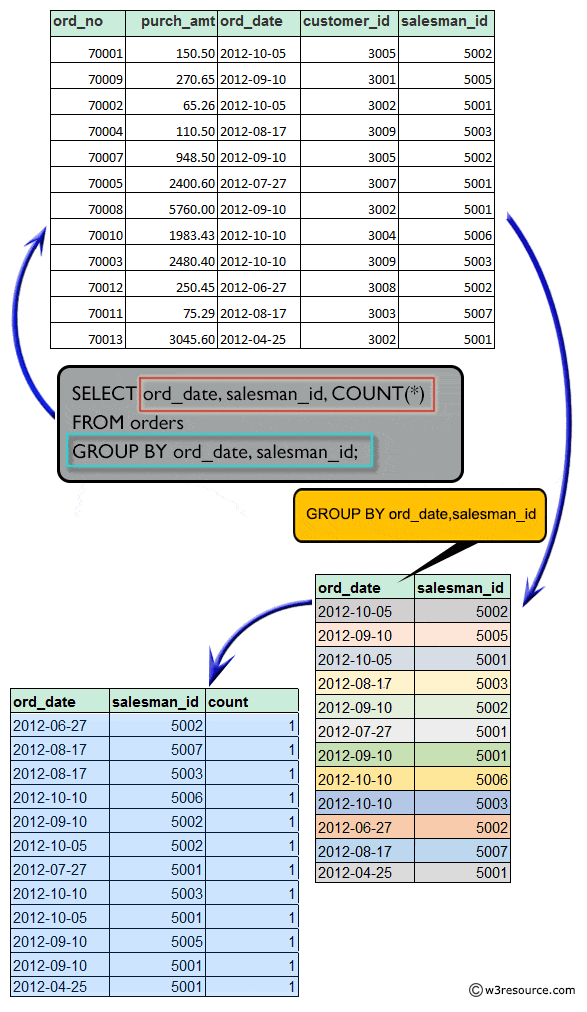SQL Exercises: Count how many salesmen each day register orders
20. Count Orders by Order Date and Salesperson
From the following table, write a SQL query to count the number of orders based on the combination of each order date and salesperson. Return order date, salesperson id.
Sample table: orders
ord_no purch_amt ord_date customer_id salesman_id ---------- ---------- ---------- ----------- ----------- 70001 150.5 2012-10-05 3005 5002 70009 270.65 2012-09-10 3001 5005 70002 65.26 2012-10-05 3002 5001 70004 110.5 2012-08-17 3009 5003 70007 948.5 2012-09-10 3005 5002 70005 2400.6 2012-07-27 3007 5001 70008 5760 2012-09-10 3002 5001 70010 1983.43 2012-10-10 3004 5006 70003 2480.4 2012-10-10 3009 5003 70012 250.45 2012-06-27 3008 5002 70011 75.29 2012-08-17 3003 5007 70013 3045.6 2012-04-25 3002 5001
Sample Solution:
-- This query counts the number of orders for each combination of 'ord_date' and 'salesman_id' in the 'orders' table.
SELECT ord_date, salesman_id, COUNT(*)
-- Specifies the table from which to retrieve the data (in this case, 'orders').
FROM orders
-- Groups the result set by the 'ord_date' and 'salesman_id' columns.
GROUP BY ord_date, salesman_id;
Output of the Query:
ord_date salesman_id count 2012-07-27 5001 1 2012-08-17 5007 1 2012-04-25 5001 1 2012-09-10 5002 1 2012-10-05 5002 1 2012-10-10 5003 1 2012-09-10 5005 1 2012-08-17 5003 1 2012-06-27 5002 1 2012-09-10 5001 1 2012-10-05 5001 1 2012-10-10 5006 1
Code Explanation:
The said SQL query that count the number of orders placed on each date by each salesman. The "GROUP BY ord_date, salesman_id" clause groups the rows in the 'orders' table by the "ord_date" and "salesman_id" columns, and the "COUNT()" function counts the number of rows in each group.
Relational Algebra Expression:
Relational Algebra Tree:
Explanation:
Visual presentation:
Go to:
PREV : Count Salespeople in a City.
NEXT : Calculate Average Product Price.
Practice Online
For more Practice: Solve these Related Problems:
- Write a SQL query to count the number of orders placed on '2012-09-10' by each salesperson.
- Write a SQL query to count the number of orders placed on '2012-10-05' by each salesperson, but only for salespeople with a commission rate of 0.14 or higher.
- Write a SQL query to count the number of orders placed on '2012-08-17' by each salesperson, but only for salespeople from the city 'Paris'.
- Write a SQL query to count the number of orders placed on '2012-07-27' by each salesperson, but only for salespeople who have made at least two sales.
Have another way to solve this solution? Contribute your code (and comments) through Disqus.
What is the difficulty level of this exercise?
Test your Programming skills with w3resource's quiz.


